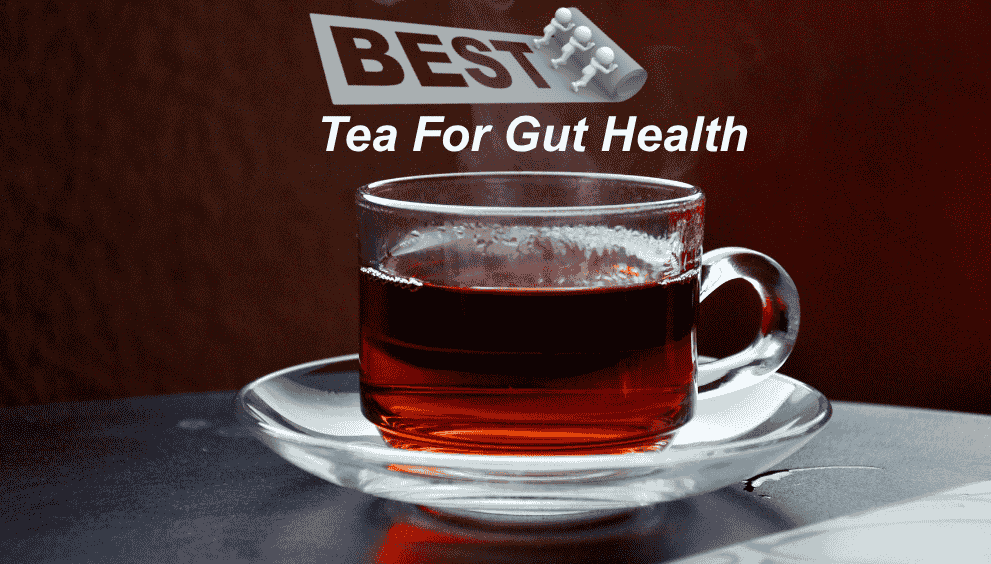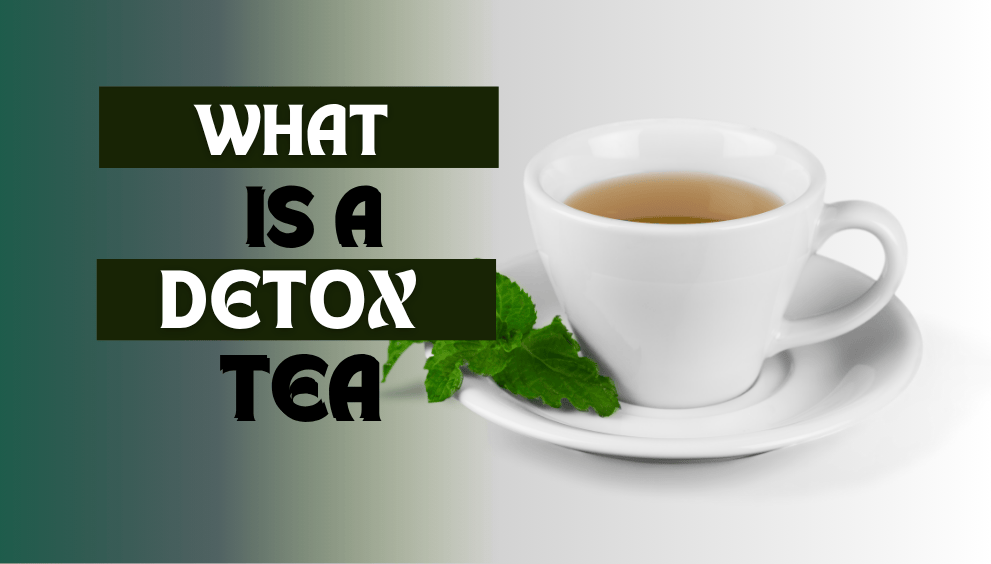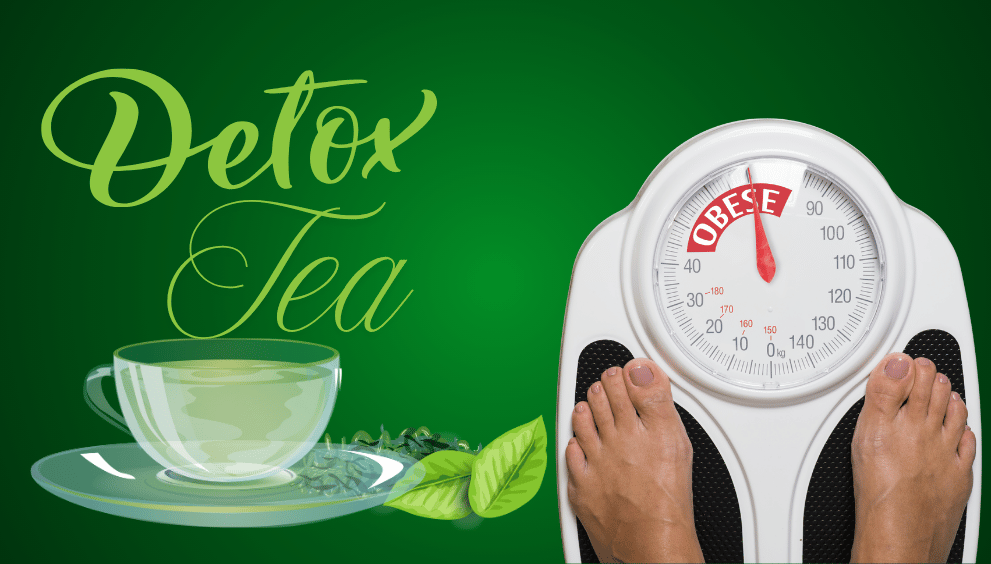Best Tea for Blood Circulation: Improve Your Flow Naturally
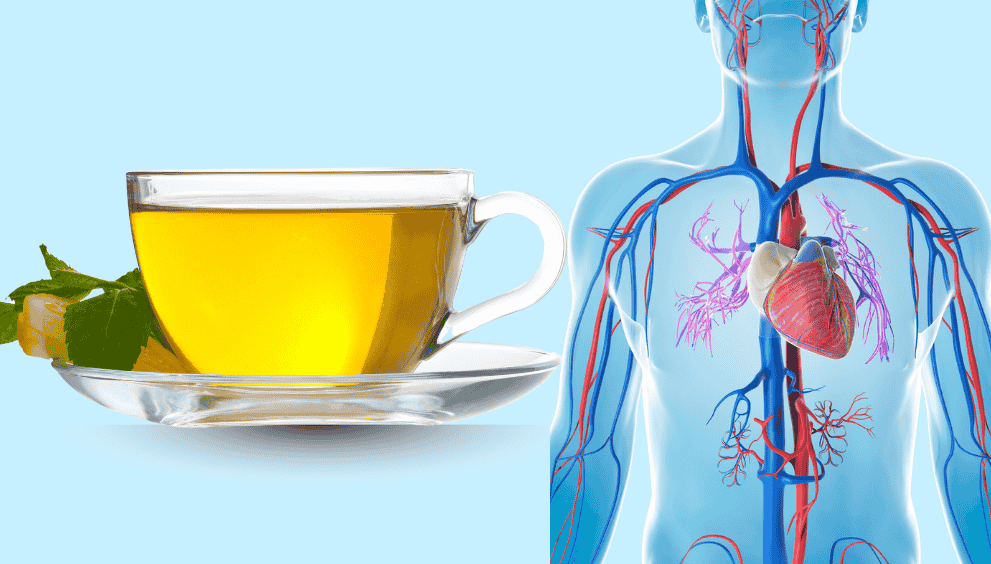
Discover the best tea for blood circulation, from green tea to ginger and hibiscus. Learn how these herbal teas support healthy blood flow naturally. What’s the Best Tea for Blood Circulation? Cold hands, tingling feet, or low energy? Poor blood flow might be the cause.
The fix could be as easy as the tea you drink. Herbal teas, such as ginger, green tea, and hibiscus, are not only soothing but also beneficial to the body. They have natural compounds that boost circulation, support heart health, and enhance vitality.
In this guide, we’ll examine the best teas supported by scientific research. We’ll explain how they work and help you find the right one for your health goals. Let’s sip our way to better circulation, one cup at a time.
- Green Tea: It’s rich in antioxidants, especially EGCG. This helps improve blood vessel function and increase nitric oxide production.
- Ginger tea acts as a natural vasodilator. This helps to widen blood vessels and improve blood flow.
- Hibiscus Tea: Lowers blood pressure and boosts artery health with potent plant flavonoids.
- Turmeric Tea: Contains curcumin, which promotes circulation by reducing inflammation and oxidative stress.
- Cinnamon Tea – Enhances circulation by improving blood flow and supporting healthy arteries.
- Ginkgo Biloba Tea: This tea boosts circulation, especially in the brain and limbs.
- Garlic tea promotes vascular health and may help reduce arterial stiffness.
Why Good Blood Circulation Matters for Your Health
What is blood circulation?
Blood circulation is the process by which your heart pumps blood through arteries and veins. This process supplies oxygen and nutrients to all the cells in your body. Healthy
Circulation supports brain function, muscle performance, heart health, and even skin glow.
Symptoms of Poor Circulation
Poor blood flow can show up in subtle ways, such as:
- Cold hands and feet
- Fatigue or low energy.
- Numbness or tingling in the limbs.
- Swelling in the legs or ankles.
- Slow-healing wounds or varicose veins
Natural Ways to Support Circulation
Regular movement and a balanced diet are essential. Additionally, some herbal teas can also be beneficial. Ginger, green tea, and hibiscus may boost blood flow. They relax blood vessels, reduce inflammation, and support heart health.
7 Best Teas for Blood Circulation (with science-backed benefits)
If you’re looking to improve your blood flow naturally, tea can be a powerful—and enjoyable—ally. Some herbal and traditional teas have compounds that widen blood vessels. They also reduce inflammation and support healthy arteries. Here are seven top teas for circulation, backed by traditional use and new research.
1. Green Tea
Green tea is one of the most studied teas for heart health benefits. It’s high in EGCG (epigallocatechin gallate), a potent antioxidant. It helps lower oxidative stress in blood vessels.
Increases nitric oxide: Green tea helps blood vessels relax and widen by improving endothelial function. This mainly happens because it affects nitric oxide production. This molecule is crucial for maintaining healthy circulation.
Lowers inflammation: EGCG cuts down inflammation in artery walls. This helps blood flow smoothly. Drinking green tea regularly may lower the risk of heart disease, according to research. They may also enjoy better circulation.
The best time to drink is in the morning or early afternoon, with or without food.
2. Ginger Tea
The Ginger tea is a warming, spicy herbal tea known for its circulation-boosting effects.
Natural Ginger is a natural vasodilator. It helps widen blood vessels, allowing blood to flow more easily. This warming effect is why people often feel a sensation of heat in their hands and feet after drinking it.
Anti-inflammatory: Ginger has gingerols and shogaols. These compounds reduce inflammation in blood vessels and support heart health.
Boosts oxygen delivery – Better circulation increases the flow of oxygen and nutrients to muscles and tissues.
The best time to drink is after meals or in the morning for optimal energy and digestion.
3. Hibiscus tea
Hibiscus tea is a deep red herbal drink. It tastes tart and is full of flavonoids and anthocyanins. These compounds help improve blood flow.
Lowers blood pressure – Research shows hibiscus tea can significantly lower systolic and diastolic blood pressure. This effect is powerful in people with prehypertension.
Boosts blood vessels – Antioxidants in hibiscus shield blood vessels from damage and enhance elasticity.
Heart-healthy: Its polyphenols may improve heart function and reduce vascular disease risk.
The best time to drink is in the afternoon or evening (caffeine-free and relaxing).
4. Turmeric Tea
Turmeric tea, brewed from the golden spice, is renowned for its potent anti-inflammatory and circulation-boosting properties.
- Curcumin boosts circulation. It improves blood flow by reducing inflammation and increasing the production of nitric oxide.
- Combines well with black pepper. Piperine in black pepper boosts curcumin absorption by up to 2,000%. This makes the tea more effective.
- Curcumin protects blood vessels. It can lower plaque buildup and make arteries less stiff, according to some studies.
Drink in the evening. Add a dash of black pepper and healthy fats, such as coconut oil, to aid in absorption.
5. Cinnamon tea
Cinnamon isn’t for desserts—it’s a powerful natural remedy for improving circulation.
- This tea boosts blood flow. It helps widen blood vessels and improves artery health. This can lower the risk of heart disease.
- Supports blood sugar control – Maintaining steady blood sugar levels is vital for good circulation. This is especially important for people with diabetes or insulin resistance.
- Anti-inflammatory effect – It contains cinnamaldehyde, a compound with potent anti-inflammatory and antimicrobial properties.
The best time to drink is mid-morning or after meals.
6. Ginkgo biloba tea
This tea comes from the ancient Ginkgo biloba tree. It is popular in traditional Chinese medicine and helps improve blood flow.
Boosts blood flow – Ginkgo helps improve circulation to the brain, hands, and feet. This is great for people with cold hands or feet or those experiencing brain fog.
Supports memory and focus. Better blood flow to the brain improves cognitive performance.
May ease claudication – Studies have shown that ginkgo may help reduce leg pain associated with poor circulation.
The best time to drink is in the morning or early afternoon to support mental clarity and focus.
7. Garlic tea
Garlic tea may not be a common choice, but it offers significant benefits for your heart and circulation. This is thanks to its special sulfur-containing compounds.
Arterial flexibility: Garlic helps blood vessels dilate and remain elastic, thereby improving blood flow.
May lower blood pressure – Compounds like allicin can lower blood pressure. Also, they protect against arterial damage.
Garlic has anti-clotting properties. It may help thin the blood a bit, which can support smoother circulation.
Best time to drink: Morning or before bed (may cause mild odor—best used when staying at home).
Final Tip: Mix and Match
You don’t have to pick one! Rotate or mix teas like ginger with turmeric or hibiscus with cinnamon. This adds flavor and boosts your results.
How to Choose the Right Circulation-Boosting Tea for You
Not all teas work the same for everyone. Choosing the best tea for better blood flow depends on your taste and health goals.
1. Consider Your Flavor Preferences
You’re more likely to stick with a daily tea habit if you enjoy the taste. Here’s a quick guide:
- Green tea has a light flavor with grassy notes and occasional bitterness.
- Ginger tea – spicy and warming, with a zing.
- Hibiscus tea – tart and fruity, often compared to cranberries.
- Turmeric tea has an earthy flavor and a mild bitterness; it pairs well with honey and lemon.
- Cinnamon tea has a sweet and aromatic flavor, providing natural comfort.
- Ginkgo biloba tea has a herbal flavor with a hint of bitterness.
- Garlic tea – strong and pungent; best with lemon or honey to soften the taste.
Tip: If you’re new to herbal teas, try cinnamon or ginger. They are tasty and easy to enjoy without sweeteners.
2. Match the tea to your health goals.
Different teas support different areas of circulation and cardiovascular wellness. Choose based on what you want to improve:
Health Goal Recommended Tea: Why?
Lower blood pressure: Hibiscus and garlic help relax arteries and reduce systolic pressure.
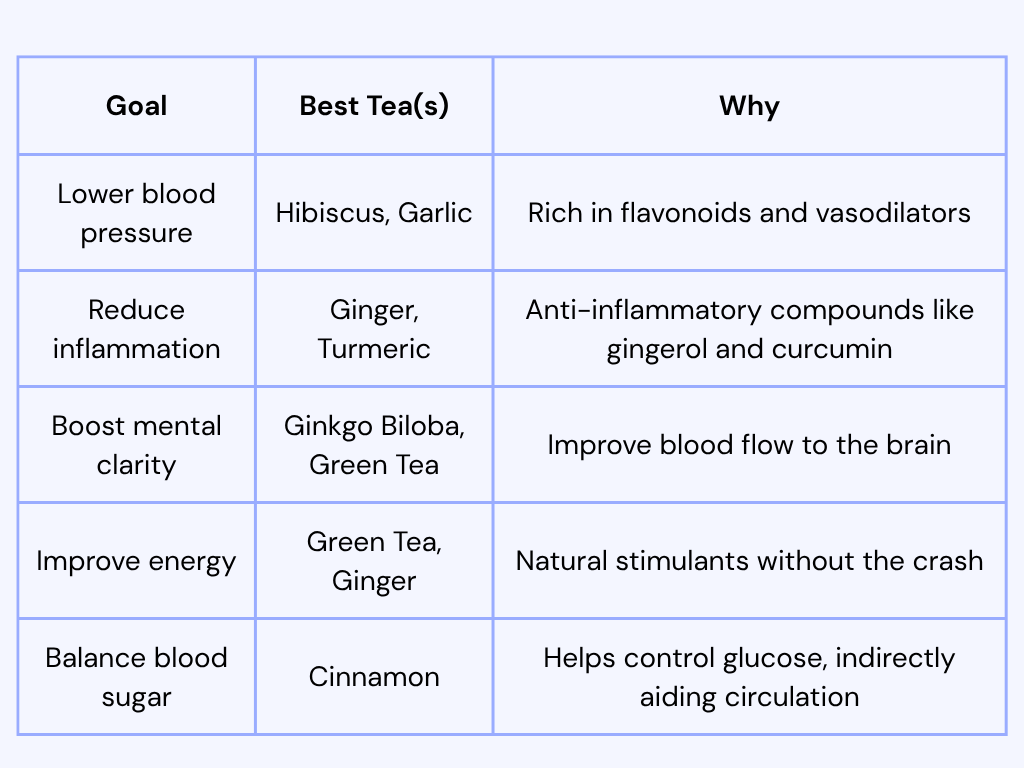
Pro tip: Rotate between a few teas to cover multiple benefits and avoid tolerance buildup.
3. Be aware of potential drug interactions and side effects.
Even natural teas can interact with medications or cause issues for certain people. Always check with your doctor if you:
- Take blood thinners (ginger, garlic, and ginkgo can increase the bleeding risk).
- Use blood pressure meds (hibiscus and garlic may enhance their effects).
- Are on diabetes medications (cinnamon and ginger may lower blood sugar).
- Are you pregnant or breastfeeding (avoid high doses of ginger, turmeric, or ginkgo)?
- Common side effects to watch for.
- Green tea can cause jitteriness or an upset stomach due to its caffeine content.
- Turmeric may cause nausea in large amounts.
- Ginger and garlic may cause heartburn or digestive upset in individuals who are sensitive to them.
Important: Start with small amounts and monitor your body’s reaction. Always consult a healthcare provider if you’re on medication.
Final Thought: Personalization is Key
There’s no one-size-fits-all tea. Your ideal pick depends on your body, preferences, and lifestyle. Begin with a goal. It could boost energy, warm cold hands, or help manage blood pressure. Then, choose the tea that enables you to achieve that.
When and how to drink tea for optimal blood circulation.
For optimal circulatory benefits from your tea, consider the timing of your drink, the method of preparation, and the amount you use. Here’s how to make the most of every cup:
1. Best Times to Drink Circulation-Boosting Tea
Timing your tea can enhance absorption and align with your body’s natural rhythms.
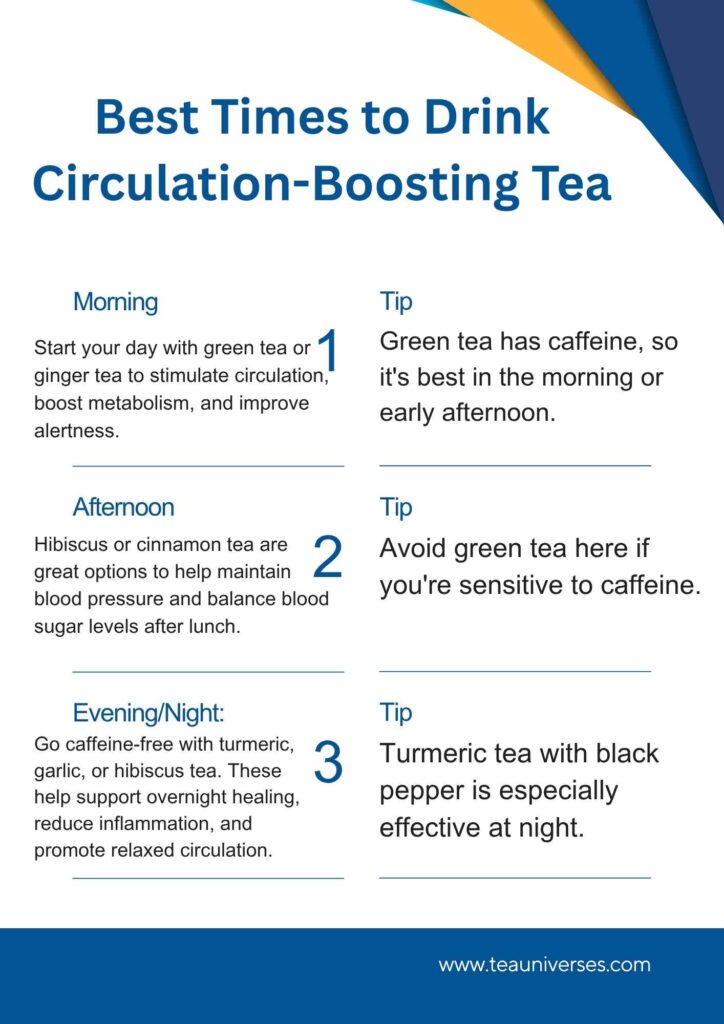
Skip caffeinated teas, like green tea, at night. This is important if you’re sensitive to stimulants or have trouble sleeping.
2. Brewing Tips for Maximum Benefits
How you prepare your tea can affect its potency. Use these tips to preserve and extract the circulation-boosting compounds:
Water Temperature:
- Green tea: ~160–180°F (not boiling to avoid bitterness)
- Herbal teas (ginger, turmeric, hibiscus): 200°F (just boiling)
Steep Time:
- Green tea: 2–3 minutes
- Herbal teas: 5–10 minutes (the longer, the stronger)
Fresh is Best:
- Use freshly grated ginger or turmeric root when possible.
- For garlic tea, crush a clove and let it sit for 10 minutes before steeping (to activate allicin).
Enhance Absorption:
- Add a pinch of black pepper to turmeric tea (to improve curcumin absorption).
- Use a slice of lemon in green or garlic tea (it adds vitamin C and enhances the flavor).
- Avoid sugar, as it can counteract the cardiovascular benefits. Use raw honey or stevia if needed.
3. Daily Recommended Intake
Most teas are safe to consume daily, but moderation is key.
Table
Rotate your teas throughout the week. This way, you can enjoy various benefits and avoid overusing one herb.
Final Tip: Make it a daily ritual.
For the best results, drink circulation-friendly tea daily. You can include it in your morning or evening routine. Consistency is what helps the herbal compounds accumulate and support long-term cardiovascular health.
Final Thoughts:
A Simple Cup Can Go a Long Way
Improving your blood circulation doesn’t have to be complicated or costly. Sometimes, it starts with a simple cup of tea.
For centuries, people have utilized herbal teas to promote heart health. Today, science supports this traditional wisdom. Nature offers the perfect remedy for many needs. You can lower your blood pressure can reduce inflammation. You can warm cold hands and feet, and can also support heart function.
Summary of the Top Circulation-Boosting Teas:
- Green Tea – Boosts nitric oxide and supports healthy arteries.
- Ginger tea – a natural vasodilator that enhances blood flow.
- Hibiscus Tea helps lower blood pressure and supports the health of blood vessels.
- Turmeric tea fights inflammation and improves endothelial function.
- Cinnamon tea helps regulate blood sugar and supports arterial health.
- Ginkgo Biloba Tea – Enhances circulation to the brain and extremities.
- Garlic tea promotes arterial flexibility and vascular relaxation.
Teas work best alongside healthy habits.
Drinking tea alone won’t fix everything. However, it is a key step when combined with a healthy lifestyle. For significant improvements in circulation and heart health, ensure you:
Move your body daily – even a brisk 20-minute walk helps boost blood flow. Consume foods that promote heart health. Focus on leafy greens, berries, nuts, fatty fish, and whole grains.
Stay hydrated: Proper hydration helps your blood flow more freely.
Manage stress: Chronic stress affects your heart and blood vessels.
Cut back on smoking, alcohol, and processed sugar. These hurt the benefits of your tea.
Try one tea this week.
You don’t have to overhaul your routine overnight. Just pick one tea from this guide — maybe ginger, hibiscus, or green tea — and make it part of your daily habit. Sip slowly, enjoy the ritual, and give your body the gentle support it needs to thrive.
Try one cup a day for seven days and notice how you feel. Sometimes, small steps can lead to the most significant changes.
Related: The 13 Best Foods to Increase Blood Flow and Circulation
FAQs: Tea and Blood Circulation
1 . Does tea help with blood circulation?
Yes, certain herbal and green teas can naturally improve blood circulation. Ingredients such as ginger, hibiscus, green tea, and turmeric are known to support heart health. They widen blood vessels and improve blood flow. This is due to their vasodilating, anti-inflammatory, and antioxidant properties.
2. Which tea is good for blood circulation?
Top teas for circulation include:
- Green tea boosts nitric oxide.
- Ginger tea acts as a natural vasodilator.
- Hibiscus tea helps lower blood pressure.
- Turmeric tea reduces inflammation.
- Cinnamon tea improves artery function.
- Each of these supports better circulation in its unique way.
- Which drink is best for blood circulation?
Aside from tea, some other drinks that support circulation include:
- Beetroot juice (rich in nitrates).
- Pomegranate juice (antioxidant powerhouse)
- Warm lemon water provides a gentle stimulation to blood vessels.
- Still, herbal teas remain the most convenient and sustainable daily option for circulation.
- What is the fastest way to increase blood flow?
The quickest ways to increase blood circulation include:
- Drinking warm ginger or green tea.
- Doing light cardio or stretching.
- Maintaining adequate hydration
- Taking a warm shower
- While tea isn’t instant, regular intake contributes to long-term improvement.
- Which herb is best for blood circulation?
Top herbs for blood flow include:
- Ginger
- Ginkgo biloba
- Turmeric
- Cayenne pepper
- Garlic
You can take all of them as teas or supplements, but tea provides a gentler and more enjoyable way to consume them.
- Is green tea or ginger tea better for blood flow?
Both are excellent, but in different ways:
Green tea has caffeine and EGCG. These compounds boost vascular function and raise nitric oxide levels. Ginger tea warms the body and widens blood vessels. If you need an energy boost, go for green tea. For warming and digestive help, choose ginger tea.
- Can I drink these teas if I have high blood pressure?
Yes, but with caution:
Hibiscus, garlic, and ginger teas have properties that lower blood pressure. They may also boost the effects of blood pressure medications. If you’re on medication, talk to your doctor first before drinking many cups daily.
- How long before I see results from drinking tea?
Most people notice subtle changes in 7–14 days of consistent tea drinking. Improved warmth in the hands and feet. Reduced blood pressure (with hibiscus or garlic tea).
A slight boost in energy or reduced fatigue.
Long-term benefits, such as improved heart health and increased artery flexibility, develop over weeks or months. This requires consistent support for intake and lifestyle.


